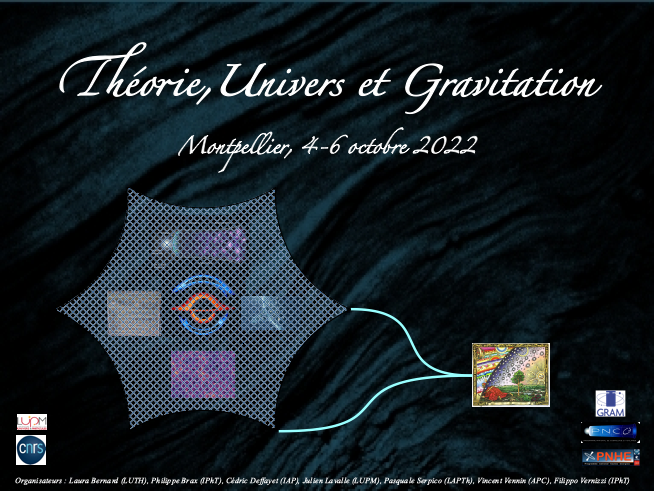The Space Time Explorer and QUantum Equivalence principle Space Test (STE-QUEST) is a M-class mission proposal that has recently been submitted to the M7 call in ESA's science program. This proposal has successfully passed the phase 1 selection and is currently under investigation for the phase 2. STE-QUEST will provide an atom interferometric measurement of the universality of free fall in...
Vacuum quantum fluctuations near horizons are known to yield correlated emission by the Hawking effect. We use a driven-dissipative quantum fluid of microcavity polaritons as an analog model of a quantum field theory on a black-hole spacetime and numerically calculate correlated emission. We show that, in addition to the Hawking effect at the sonic horizon, quantum fluctuations may result in a...
Three-body systems are very common in the universe and it is likely that future gravitational-wave detectors will detect and measure the parameters of such systems. I will describe an interesting relativistic resonance taking place in hierarchical three-body systems when the precession frequency of an inner binary black hole matches the period of an outer perturber object. I will show how this...
Maximally symmetric spacetimes are well known to be stable under small metric perturbations if they propagate into the vacuum. But this statement is not always verified in the presence of matter.
Starobinsky inflation is based on the idea that a quantum Conformal Field Theory (CFT) backreacts in an initial de Sitter spacetime, driving it to a FLRW spacetime after a period of...
Notoriously, scalar primordial non-Gaussianities constitute a key prediction of the inflationary paradigm that is yet to be discovered. Less famous, tensor non-Gaussianities as well as mixed scalar-tensor non-Gaussianities may also arise from non-linear interactions in the early Universe.
In this talk, I will explain how the latter types of bispectra (the three-point functions) may be...
Inflation is a widely accepted paradigm explaining the origin of the observed spatial correlation in cosmological structures. However, the physics of inflation remains elusive, and a key challenge of primordial cosmology is to decipher it through the study of cosmological correlators, which notably encode high-energy physics effects during inflation. Both on theoretical and practical grounds,...
We present new results on gravitational matter production in the late time evolution of inflation, during coherent oscillation regime of the inflationary field, usually called "reheating". We consider the production of matter and radiation during reheating after inflation, restricting our attention to gravitational interactions, including minimal and non-minimal coupling to gravity. In...
Observations of the 21 cm line of atomic hydrogen with radio telescopes will provide an unparalleled probe of the Universe between reionization ($z\sim$ 6-12) and cosmic dawn ($z\simeq$ 30). Because exotic energy injection in the intergalactic medium via dark matter decay or annihilation can be particularly efficient in that redshift range (due to a long lifetime or clustering into halos), the...
In this talk, I will present the first constraints on decaying cold dark matter (DCDM) models thanks to the effective field theory of large scale structure (EFTofLSS) applied to BOSS-DR12 data. I will consider two phenomenological models of DCDM: i) a model where a fraction $f_{\rm dcdm}$ of cold dark matter (CDM) decays into dark radiation (DR) with a lifetime $\tau$; ii) a model (recently...
Black holes formed in the early Universe (PBHs) could constitute (a component of) the dark matter. In this talk I will consider primordial black holes (PBHs) of O(1) - O(100) solar masses. First, I will discuss the possibility of detecting PBHs in the Milky Way through the process of gas accretion, presenting a comprehensive study of the uncertainties associated to this observation channel....
In this paper, we present an experiment based on 1) the application of a strong electric field inside a microwave cavity and 2) electrometry using Rydberg atoms. This kind of experiment could be extremely useful at detecting dark photons through the stationary electric field filling the whole space it induces. The sensitivity of this experiment is significantly enhanced around the resonances...
Fuzzy Dark Matter (FDM) models admit self-similar solutions which are very different from their Cold Dark Matter (CDM) counterparts and do not converge to the latter in the semiclassical limit. In contrast with the familiar CDM hierarchical collapse, they correspond to an inverse-hierarchy blow-up. Constant-mass shells start in the nonlinear regime, at early times, with small radii and high...
We investigate the flow around a black hole moving through a cloud of self-interacting scalar dark matter. We focus on the large scalar mass limit, with quartic self-interactions, and on the subsonic regime. We show how the scalar field behaves as a perfect gas of adiabatic index $\gamma_{\rm ad}=2$ at large radii while the accretion rate is governed by the relativistic regime close to the...
In this talk I will present the fact that the quantum field theory treatment of entangled relativity requires the existence of a new fundamental quantum of action that is not the usual constant of Planck (hbar). Instead, in entangled relativity, hbar can be thought to be an effective late times and low energy limit quantum of action, which therefore depends on the spacetime localisation. I...

